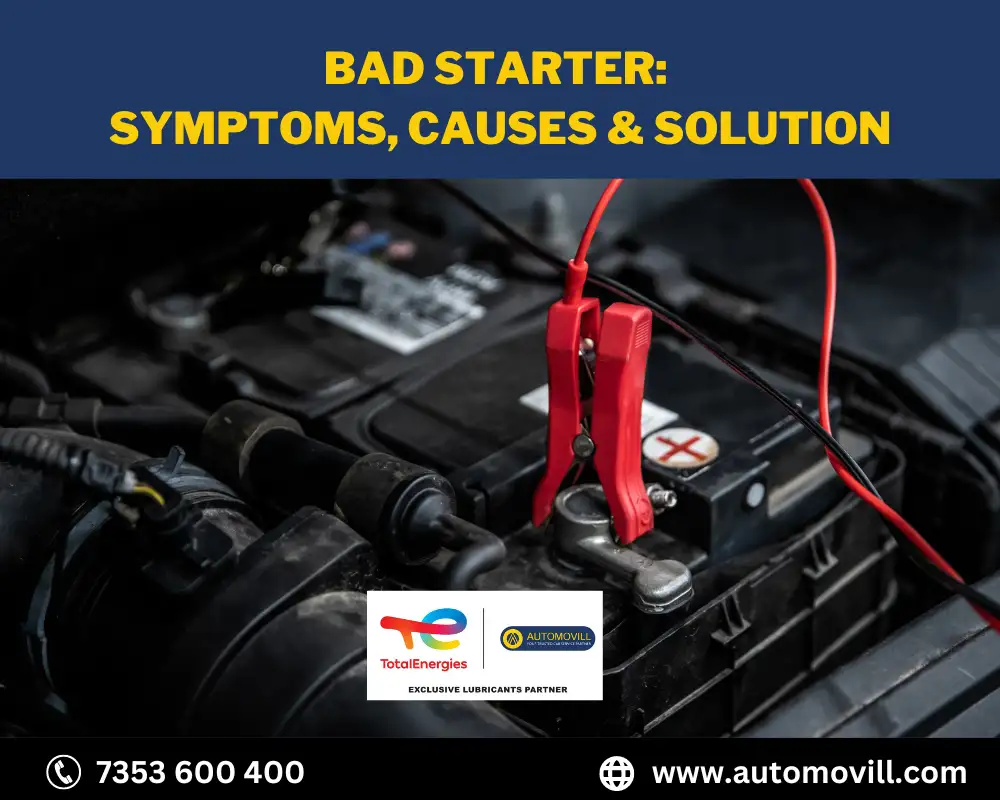
The starter is a vital component of your car’s starting system that initiates the engine’s operation. However, like any mechanical part, it can experience problems over time. Recognizing the symptoms of a bad starter is crucial in diagnosing the issue early and preventing unexpected breakdowns.
In this blog, we will explore six common symptoms of a bad starter and discuss relevant subheadings to help you understand and address potential problems effectively.
What is a Starter?
A starter is a device in your car that helps to start the engine. When you want to start your car, you turn the key or press a button, and the starter gets activated. It is like a small electric motor that connects to the engine’s moving parts.
The starter’s main job is to make the engine start spinning. It does this by engaging with a part called the flywheel (or flexplate), which is connected to the engine’s crankshaft. When the starter receives a signal from the ignition, it engages with the flywheel and makes it rotate.
By making the flywheel spin, the starter creates the energy needed to start the engine. Once the engine is running, the starter disengages from the flywheel, allowing the engine to keep spinning on its own.
At this point, other parts of the car’s system take over, like the battery and the alternator, which provide power to the electrical components and recharge the battery.
6 Symptoms of a Bad Starter
Here we go:
1. Engine Cranks Slowly
- When you turn the ignition key, if the engine cranks slowly or takes longer than usual to start, it may indicate a weak or failing starter motor.
- The engine might sound sluggish, struggle to start or produce clicking sounds during the cranking process.
2. No Response when Turning the Key
- If turning the ignition key produces no response at all, it can signify a complete failure of the starter motor.
- You may hear no sounds, such as clicking or whirring, suggesting that the starter isn’t engaging with the flywheel.
3. Grinding Noise
- A grinding noise when attempting to start the car might indicate a worn-out starter gear or a faulty flywheel.
- The sound may resemble metal rubbing against metal, suggesting a need for immediate inspection and repair.
4. Frequent Need for Jump Starts
- Requiring frequent jump starts, even with a fully charged battery, is another sign of a faulty starter.
- If the battery is in good condition, but the engine fails to start without external assistance, the starter could be at fault.
5. Smoke or Burning Odor
- Smoke or a burning smell coming from the starter area is an alarming symptom that should not be ignored.
- It could indicate an electrical issue, such as overheating wires or a short circuit within the starter motor.
6. Dashboard Lights Flicker
- When starting the car, if the dashboard lights flicker or become dim, it could suggest a power shortage due to a faulty starter.
- The starter motor drawing excessive current can cause voltage drops, affecting other electrical components.
Possible Causes of a Bad Starter
Under this subheading, we will discuss some common causes that can lead to a bad starter. It’s important to understand these causes as they can help you prevent future starter issues. Here are a few potential reasons:
- Wear and Tear: Over time, the starter motor’s internal components can wear out due to continuous use. This can include worn brushes, a damaged armature, or a faulty solenoid, among other things.
- Electrical Problems: Issues with the electrical connections to the starter can affect its performance. Loose or corroded connections, damaged wiring, or a faulty ignition switch can disrupt the flow of electricity and lead to starter problems.
- Faulty Solenoid: The solenoid is responsible for engaging the starter motor with the flywheel. If the solenoid becomes worn out or malfunctions, it can prevent the starter from engaging properly, resulting in starting difficulties.
- Improper Installation: If the starter was not installed correctly or if incompatible components were used during installation, it can cause premature starter failure or poor performance.
What to Do When You Experience Starter Problems?
It’s important to handle these issues properly to prevent further damage and ensure the safety of yourself and your vehicle. Here are a few actions you can take:
- Check the Battery: Before assuming it’s a starter issue, make sure the battery is in good condition. Check for loose connections, corrosion, or a weak battery. If necessary, charge or replace the battery.
- Verify the Ignition Switch: The ignition switch plays a crucial role in starting your vehicle. Ensure that it is functioning correctly by checking if the dashboard lights come on when you turn the key. If the lights don’t come on or flicker, the ignition switch may be faulty.
- Inspect the Starter Connections: Examine the electrical connections to the starter motor. Look for loose or corroded wires and terminals. Clean and tighten the connections as needed.
- Tap the Starter: Sometimes, a starter can get stuck or develop a “dead spot.” Gently tap the starter motor with a non-metallic object, such as a rubber mallet or a wooden dowel, while someone tries to start the engine. This might temporarily resolve the issue, but it’s recommended to seek professional assistance afterward.
Conclusion
Recognizing the symptoms of a bad starter is essential for maintaining your vehicle’s reliability. By identifying these signs early on, you can address the issue promptly and avoid potential breakdowns.
If you experience any of the mentioned symptoms, it’s crucial to consult a professional mechanic to diagnose and resolve starter-related problems efficiently.
Remember, taking care of your car’s starting system ensures smooth and hassle-free driving experiences.
